Our Emeriti Faculty:
Where Are They Now?
The honorary title “emeritus,” or “emerita” for a woman, derives from the Latin emereri, “to earn by service.” It is bestowed upon selected faculty, and some others, upon their retirement, normally after long and noteworthy tenures. Some 74 retired St. Lawrence faculty members hold that rank; collectively, they taught at the University for over 2,000 years.
We asked them to reflect upon their careers and bring us up to date on their lives in retirement, and many kindly responded – so many, in fact, that we can fit only half of them into this issue, so if you don’t see your favorite former professor here, stay tuned till next time. Three take-aways: they are not sitting around in rocking chairs very much; a great many have stayed in Canton, although some gleefully sneak away in winter; and several are still teaching in one form or another, and pursuing scholarship.
John W. Barthelme
Anthropology
Named Emeritus: 2009
Lives in: Carthage, Tennessee
“I hope to write a field guide to the spiders of Arizona.”
Professor Barthelme is no longer engaged in archaeological field work in Kenya, but continues to write up field and analysis results of 20 years of work at Lake Magadi. A month after he retired, his article based on fieldwork as part of his Summerterm 2007 and 2008 archaeological field course was published in an African journal.
An ardent naturalist, Barthelme reported in May that he had “just returned from a month of spider, scorpion and centipede collecting in southern Arizona.” He added, “If enthusiasm, time and health permit I hope to write a field guide to the spiders of Arizona,” where he consults on and participates in archaeological surveys. He’s working on papers on spiders that mimic ants and on spiders that live in pitcher plants. “Both ideas came from traveling and viewing spiders in Kenya and Madagascar,” he explains. Other activities include birding, gardening and traveling; the veteran of a grueling three-week camel ride accompanying a salt caravan across the Sahara has trips in the works back to Morocco (“where knee surgery cut short a trip in 2005; I fell off a cliff in the High Atlas Mountains,” he confesses), Spain and Greece.
A 31-year career at SLU produced an array of memories. One clear one is “the white-tailed deer butchery for my Neandertal class. I vividly remember the looks of amazement and horror on student faces as they encountered the dead and field-dressed deer hanging from iron supports. However, as they manufactured Neandertal replica stone tools and used them to remove the hide and dismember the carcass, most of the students really got into it. At the follow-up dinner of grilled venison (thanks to dining services) we discussed the experience. Most students had a greatly enhanced respect for Neandertal hunters as well as the efficiency of stone tools. Several vowed to carry stone tools instead of a pocket knife!”
He also recalls “the puzzled looks on many student faces when, during a Human Anatomy lab, they discovered males DO NOT have one less rib than females, via the Adam and Eve myth. I had upset their orthodox view of the world... as I intended to.”
And there was the student who thanked the professor for giving him an F. “It really shook him up,” Barthelme says. “He decided to re-think his education. He became a real student. It changed his life.” --NSB
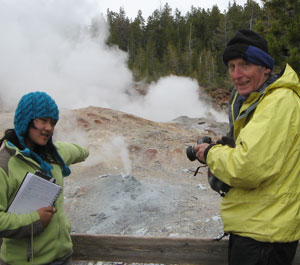
John T. Bursnall
Geology
Named Emeritus: 2006
Lives in: Rensselaer Falls, New York
“Teaching was, and still is, how I identify myself.”
John Bursnall may have retired, but he hasn’t stopped teaching. He has taught two First-Year Seminars, stepped in and taught two courses for a month at SUNY Potsdam while a colleague there was recovering from surgery, and taught two SOAR courses. This spring, under the moniker “emeritus lecturer in geology,” he taught two courses for SLU geology majors, one with a May field trip to Yellowstone National Park, where he is pictured with his daughter, Teya. He also chaired a review committee of the geology department at another institution.
“Teaching was, and still is, how I identify myself,” says Bursnall. “Clearly, St. Lawrence has been a major component of that, since I settled down from a somewhat nomadic professional start to teaching here for several years.”
Outside of the classroom, Bursnall has also done volunteer work for Literacy Volunteers of Northern New York and the Indian Creek Nature Center, which is near his home; he is one of a dozen or so directors. In addition, he has continued as faculty mentor to the SLU squash teams and was assistant coach last year.
He continues to attend professional conferences, saying it is gratifying to meet up with past geology majors and to see that the department has maintained its position as among the top in the country as undergraduate sources of earth science Ph.D’s. “I was very lucky to have found St. Lawrence,” he concludes. --Josh Johnson ’10
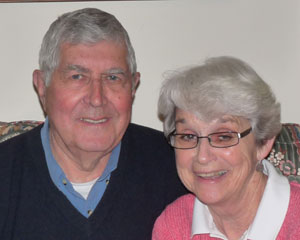
John W. Hall Dorothy Q. “Dotty” Hall
Education Sport and Leisure Studies / Coach
Named Emeritus: 2000 Named Emerita: 2000
Live in: Canton, New York
“Helping others makes my life more complete.” (John Hall)
“Now (my students) teach me.” (Dotty Hall)
John Hall’s favorite memories at St. Lawrence all deal with helping students realize their potential. “Teaching at St. Lawrence reinforced and strengthened my belief that helping others makes my life more complete,” he says.
The retired education professor maintains a certified tree farm a few miles south of Canton. Also, he is working with the New York State Department of Environmental Conservation to create a sustainable woodlot. He and his wife, Dotty, grow a large garden of flowers and vegetables at their home on a side street in Canton, and enjoy their cottage on the St. Lawrence River, “especially when we are visited by our grandchildren and their parents,” he adds.
In addition to enjoying gardening and her family, former coach of field hockey, women’s lacrosse and women’s tennis Dotty Hall has written one book on the history of women’s athletics at St. Lawrence, and is hard at work on another. Over three decades of teaching and coaching at St. Lawrence provided countless positive memories. “Each provided many opportunities to get to know student-athletes beyond the classroom and the playing fields,” she says. “Now they teach me, and they also beat me at golf!”
These days, she says, she “enjoys playing instead of coaching, writing instead of grading, and learning about grandparenthood.” She has taken up photography and looks forward to touring Adirondack waters in kayaks with friends. --Josh Johnson ’10
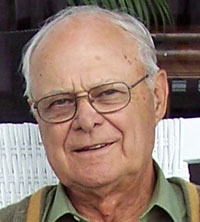 Harlan H. Holladay
Harlan H. Holladay
Fine Arts
Named Flint Professor Emeritus: 1991
Lives in: Cape Girardeau, Missouri
“I learned more than many of my students. Thanks!”
Professor Holladay says he has “too many memories to separate. I was honored to be a part of a distinguished faculty,” he continues. “Like all teachers, I remember the better students (you know who you are) and a few of the worst (I have forgotten your names). As the department, gallery and collection grew from one person (me) to a dozen faculty offering a curriculum worthy of a major, I learned more than many of my students. Thanks!”
“DocH3”, as he still refers to himself, and his wife, Ruffena, travel extensively, throughout the U.S., to Europe several times, to Turkey and to China. He has continued his membership in the College Art Association and attends annual meetings “when they are held in cities we would like visit.” He adds, “I continue to read professional journals, histories and several periodicals. We do modest hikes; no more skiing or squash, and, unfortunately, very little golf recently.”
They live in a retirement community in the Mississippi River town where he grew up and not far from his wife’s roots, “to be in a milder climate and near remaining relatives. All goes well,” he concludes. --NSB
Richard D. Kepes
English
Named Emeritus: 1989
Lives in: Canton, New York
“Kepes grew chickens, vegetables and grandchildren…” The professor with his grandson Jay in 1996.
For Dick Kepes, January Interterm was a time to try new ideas, to see what projects he could encourage students to do. One year he taught Beginning Japanese; another year he recruited students to put together a newspaper, The Interterm Daily (“that was a struggle”); and once, before computers, he offered a writing class with the requirement of 10 pages of writing every day.
After he retired, Kepes grew chickens, vegetables and grandchildren on his farm a couple of miles south of Canton. All the crops received lavish attention -- the chickens in their airy coop; the vegetables in manicured, hand-dug raised beds; and the grandchildren, kids who knew their grandfather would always stop work to sit with them and read a picture book or two.
Two grandsons are now taller than their six-foot-four grandfather, and all seven grandchildren are past the picture book stage. These days the kids enjoy sitting with their grandfather to listen to vintage records from his extensive collection, marveling at the ancient technology of a turntable and a needle. --Betsy Kepes
Ruth Hinkle Kreuzer
Modern Languages and Literatures (Russian)
Named Emerita: 2004
Lives in: Canton, New York
“Learning is still my real passion and pleasure.”
Ruth Kreuzer may have retired, but she couldn’t escape her love of the classroom and returned to teach. Her First-Year Seminar course on St. Petersburg and her Russian literature courses were revamped into courses for SOAR.
Her fields might have been modern languages and Russian literature, but Kreuzer also taught her students how to create simple Web pages from scratch and emphasized the importance of technology. “One of the highlights of my teaching career was when one graduating senior, who had struggled with the technology, came to my office to tell me she got her dream job because she knew how to create a Web site,” says Kreuzer.
The most popular course she organizes for SOAR each semester is Vicarious Voyagers. “I share my own travel experiences, to Greece, England, Iceland, and help others put together their own travelogue presentations for the course,” she says.
Other components of her life include music, yoga and photography. She sits on the boards of SOAR, where she is “the PR person,” Web master and Curriculum Committee co-chair, and the Yoga Loft in Canton. “Though teaching and sharing my skills, many of which I learned and honed while teaching at SLU, is still a good part of my life, learning is still my real passion and pleasure,” Kreuzer observes. --Nora Wolinsky ’10
Robert A. Lufburrow
Physics
Named Emeritus: 1984
Lives in: Roseburg, Oregon
Professor Lufburrow in his teaching days. “The junior faculty saw me brandishing the mace.... ”
Bob Lufburrow recalls “the time I stood in for (the late) Bill Elberty (’53 of geology) as grand marshal and mace-bearer in one of our gowned processions into the chapel. The faculty was organized with the junior members at the head of the line and senior members at the rear. I explained to them that as we moved down the center aisle the junior members were to peel off at the rear pews row by row so that the senior members would be seated in front.
“I then led the faculty into Gunnison and, to the swelling organ music, down the aisle carrying the mace with proper pride,” Lufburrow continues. “I expected that the routine was understood, so I did not turn to view the proceedings until I was half-way down the rows of vacant pews. Whereupon I saw that the junior members had followed me without moving into their rows. I gave a wild look, raised the mace and moved forward to direct traffic.
“The junior faculty saw me approaching, wild-eyed and brandishing the mace, and their faces showed well their concern,” he recounts. “We did get the seating started, and the rest was routine. Elberty returned before the next procession, and I returned to my old task of getting the faculty organized for those occasions, leaving the directing to him.” --NSB
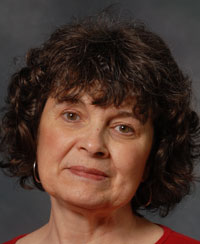 Laura Nuzzi 0’Shaughnessy
Laura Nuzzi 0’Shaughnessy
Government
Named Dana Professor Emerita: 2008
Lives in: Great Barrington, Mass.
“The pursuit of knowledge is never-ending.”
Laura O’Shaughnessy says her favorite memories of teaching at SLU are of springtime, when everyone looked forward to warm weather and sunshine. Weather permitting, she would hold her classes outside on the lawn between Hepburn Hall, Carnegie and ODY. “Being out of doors certainly changed the structure of class learning, but the informality also made many students willing to join in the discussions,” she remembers.
O’Shaughnessy appreciates the teaching profession because “you realize that the pursuit of knowledge is never-ending. It keeps you reading new material, comparing the new ideas to what you thought you knew for sure,” she says. “One of the most valuable aspects of teaching at SLU was the challenge of making my students realize that we are capable of learning together in our continual quest for knowledge and explanations.”
Since her retirement, O’Shaughnessy has relocated to the Berkshire Mountains of Massachusetts to be near two of her grandchildren. She left college teaching to pursue a second career as an ordained minister in the United Church of Christ. “I am not exactly sure what path my ministry will take, so I am in a time of life changes and discernment of my future,” she reports. “Ministry is like teaching; they are caring, thought-provoking, challenging professions.” --Josh Johnson ’10
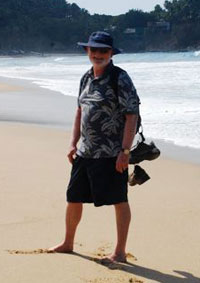 Alan M. Schwartz
Alan M. Schwartz
Environmental Studies
Named Emeritus: 2007
Lives in: Canton, New York
“I was allowed to work with students to shape environmental policies.”
“St. Lawrence was the perfect place for me to spend my career because it gave me opportunities to grow and experiment in many ways,” says Alan Schwartz. “I was able to develop new courses that challenged both me and my students, and I was allowed to work with students to shape environmental policies at SLU.”
Since retiring, Schwartz has sailed a large catamaran to the Bahamas and directed the London Program. “The hope is that retirement will provide opportunities that you could not take advantage of when you were teaching because of time constraints. For me that has been true,” says Schwartz.
For the last three years, he has been spending winters in Mexico, escaping the cold weather and exploring the country through research and travel. When he returns to Canton this fall, Schwartz is planning on sitting in on a course on the area – although “I struggled through Intro to Spanish,” he confesses. He also plans to work with Habitat for Humanity.
Schwartz enjoys hearing from alumni who were in one of his classes. And it’s not just his majors and advisees. “Sometimes I’ll get a letter from a former student I had only in an intro class,” he explains. “It will give some variant of a story that the course was really meaningful and set the student on a path in life that has led to some career or community service that was sparked by the issues covered in the class. That tells me this person is making a difference and that it started in my class.” --Nora Wolinsky ’10
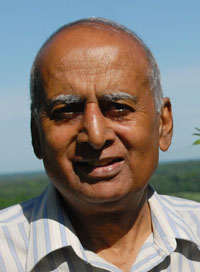 Chanchal Singh
Chanchal Singh
Mathematics
Named Cummings Professor Emeritus: 2003
Lives in: Canton, New York
“Some students have become my lifelong friends.”
Chanchal Singh says he misses the classroom environment most, in particular the wonderful students and the opportunity to teach them. “As my students learned from me, I learned from them and some of them have become my lifelong friends,” says Singh. “They were eager to learn and were full of life and enthusiasm. Some of the senior theses I directed left a lasting impression on me.”
Singh says St. Lawrence made his scholarship “very easy with so many resources, allowing me to grow intellectually both in and outside of my field. Research made me a better teacher,” he states.
Despite missing teaching, Singh now has the time to pursue some of the interests and hobbies that he always wanted to. “I began gardening, growing fruits and vegetables, studying mysticism, and doing some carpentry,” he explains. He has branched out from mathematics, studying non-mathematical writing, writing short fiction and making art objects with stained glass. You can find him on campus, working out regularly in the Fitness Center, and he has joined the reading group started by Professor Danielle Egan. --Nora Wolinsky ’10
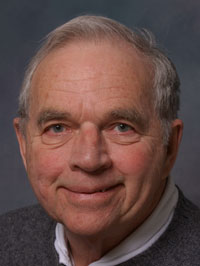 Robert N. Wells Jr.
Robert N. Wells Jr.
Government
Named Munsil Professor Emeritus: 1999
Lives in: Canton, New York
“Research and writing on the St. Regis Akwesasne Mohawks.”
Bob Wells says he will always remember taking his Presidents class to Washington, D.C., where they met with President Jimmy Carter and Vice President Walter Mondale P’82 and their staffs.
Always active in civic affairs, Wells has ratcheted up those activities in retirement. He has served as Mayor of Canton, been an adjunct faculty member in the First-Year Seminar, taught in the SOAR program, been a founding member of the Canton Community Fund and president of the Canton Library Board, and chaired a local public television station’s $9 million capital campaign. And that’s just the major involvements.
Wells has also written a book on New York State politics. And he’s continuing work he began as a professor. “I am currently doing research and writing on the St. Regis Akwesasne Mohawks, with whom I worked for 30 years prior to my retirement,” he explains. He still enjoys going to home hockey games (a plaque on the rail marks the spot where he and his wife, Pat, stand), particularly women’s games, coached by his son, Chris ’92. --Nora Wolinsky ’10
About Our Writers
Nora Wolinsky and Josh Johnson, of St. Albans, Vt., and Bemus Point, N.Y., respectively, were senior writing interns in the University communications office in spring 2010; Neal Burdick ’72 has been editor of this magazine for 33 years, and took courses from some of the emeriti profiled here; Betsy Kepes is a freelance writer and music teacher who lives in Pierrepont, N.Y., and, yes, is related to the professor of whom she writes.



